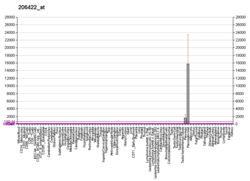| GCG |
|---|
|
| Available structures |
|---|
| PDB | Ortholog search: PDBe RCSB |
|---|
| List of PDB id codes |
|---|
1BH0, 1NAU, 2G49, 2M5P, 2M5Q,%%s4ZGM, 4APD, 3IOL, 1D0R,%%s2L64, 2L63 |
|
|
| Identifiers |
|---|
| Aliases | GCG, GLP1, glucagon, GRPP, GLP-1, GLP2 |
|---|
| External IDs | OMIM: 138030; MGI: 95674; HomoloGene: 136497; GeneCards: GCG; OMA:GCG - orthologs |
|---|
| Gene location (Human) |
|---|
 | | Chr. | Chromosome 2 (human)[1] |
|---|
| | Band | 2q24.2 | Start | 162,142,882 bp[1] |
|---|
| End | 162,152,404 bp[1] |
|---|
|
| Gene location (Mouse) |
|---|
 | | Chr. | Chromosome 2 (mouse)[2] |
|---|
| | Band | 2 C1.3|2 35.85 cM | Start | 62,304,874 bp[2] |
|---|
| End | 62,313,994 bp[2] |
|---|
|
| RNA expression pattern |
|---|
| Bgee | | Human | Mouse (ortholog) |
|---|
| Top expressed in | - beta cell
- body of pancreas
- rectum
- mucosa of sigmoid colon
- mucosa of ileum
- testicle
- mucosa of transverse colon
- epithelium of colon
- jejunal mucosa
- appendix
|
| | Top expressed in | - islet of Langerhans
- crypt of lieberkuhn of small intestine
- ileum
- large intestine
- colon
- lens
- Paneth cell
- left colon
- jejunum
- epithelium of small intestine
|
| | More reference expression data |
|
|---|
| BioGPS |  | | More reference expression data |
|
|---|
|
| Gene ontology |
|---|
| Molecular function | - protein binding
- identical protein binding
- hormone activity
- glucagon receptor binding
- signaling receptor binding
| | Cellular component | - cytoplasm
- endoplasmic reticulum lumen
- extracellular region
- secretory granule lumen
- extracellular space
| | Biological process | - negative regulation of execution phase of apoptosis
- G protein-coupled receptor signaling pathway
- regulation of insulin secretion
- cellular response to glucagon stimulus
- positive regulation of peptidyl-serine phosphorylation
- positive regulation of calcium ion import
- positive regulation of histone H3-K4 methylation
- positive regulation of peptidyl-threonine phosphorylation
- feeding behavior
- positive regulation of ERK1 and ERK2 cascade
- positive regulation of protein binding
- cell population proliferation
- signal transduction
- positive regulation of protein kinase activity
- adenylate cyclase-modulating G protein-coupled receptor signaling pathway
- protein kinase A signaling
- positive regulation of insulin secretion involved in cellular response to glucose stimulus
- response to starvation
- negative regulation of apoptotic process
- regulation of signaling receptor activity
- adenylate cyclase-activating G protein-coupled receptor signaling pathway
| | Sources:Amigo / QuickGO |
|
|
| Wikidata |
| View/Edit Human | View/Edit Mouse |
|

















